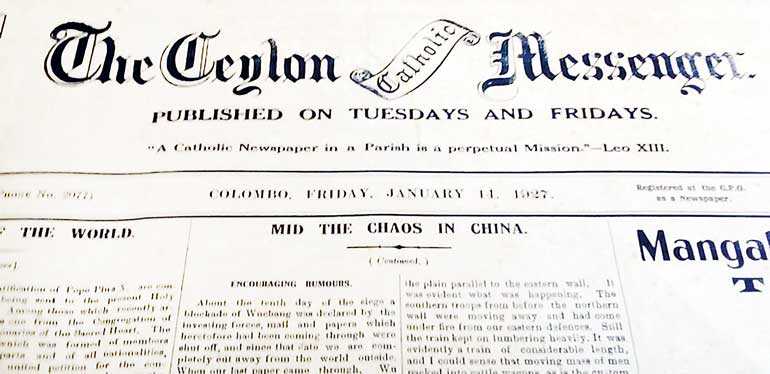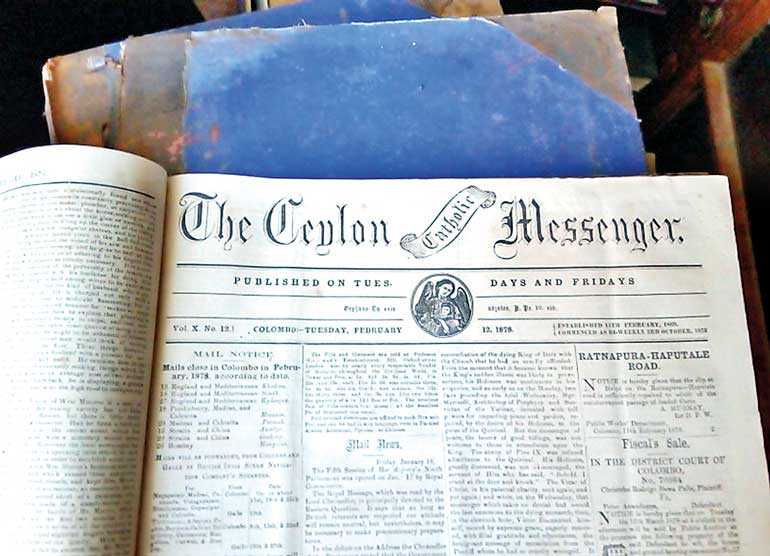Tuesday Dec 09, 2025
Tuesday Dec 09, 2025
Monday, 16 December 2019 00:15 - - {{hitsCtrl.values.hits}}


By E. Weerapperuma
The Messenger, the Catholic weekly of Sri Lanka, today celebrates its grand anniversary of 150 years serving the Church, the local Catholic community and the country.
A special ceremony is scheduled to be held this evening at around 6.00 p.m. to celebrate the landmark, under the title ‘Sesquicentennial Jubilee of the Messenger, the Catholic Weekly of Sri Lanka’. Archbishop of Colombo Cardinal Malcolm Ranjith will be the event’s Chief Guest.
He will be accompanied by the Vatican Delegate in Sri Lanka Nuncio Archbishop Pierre Nguyen Van Tot, the Member Bishops of the Catholic Bishops’ Conference of Sri Lanka, the Auxiliaries of Colombo Archdiocese Rt. Rev. Dr. Maxwell Silva and Rev. Fr. J.D. Anthony Jayakody. Priests, religious officials and laity will join the jubilee celebration due to take place at the auditorium of Archbishop’s House in Borella. The ceremony to mark the jubilee was slated to be held earlier but had to be postponed in the aftermath of the Easter Sunday attacks.
The Messenger passed this anniversary milepost on 11 February this year, entering into the realm of supremacy in the Sri Lanka English newspaper kingdom. To this day it is the longest circulating English newspaper in Sri Lanka, either religious or secular, being printed for the first time in 1869. Both The Messenger, the Catholic Weekly of Sri Lanka and the Sinhala Weekly Gnanartha Pradeepaya were printed in a private letter press machine of the day, owned by a group of Catholic entrepreneurs.
The Messenger has served the nation, especially the country’s Catholic community, for the past 15 decades. Hence it is time to commend it for its yeoman service to one and all.
In the presence of the distinguished gathering at the Archbishop’s auditorium today, memories of the days gone by will be refreshed and a souvenir to this effect will be released.
The first copy of the souvenir is scheduled to be presented to Cardinal Ranjith by The Messenger Editor Rev. Fr. Dr. Camillus Fernando. Fr. Fernando is also the Editor of Gnanartha Pradeepaya cum Lama Pradeepaya and is also the Director of the Colombo Catholic Press.
The Messenger has introduced a unique perspective to Sri Lankan journalism, a fresh layer of truth and a renewal of human values. Its patent sincerity, honesty, balanced viewpoints, judicious moderation and firm but dignified language have commanded respect in the highest intellectual circles. The reason for all this is the obedience to the Christian command to “spread the good news”.
Lay roots
The founder of The Messenger was a layman Francis Fonseka. Fifteen decades ago Fonseka established an apostolate of the print media, joyfully joining to work under the guidance and supervision of Rt. Rev. Dr. Hilari Sillani OSB, the then-Vicar Apostolate. The sheet of paper, as it was referred to then, had ‘Ceylon Catholic Messenger’ as its masthead. Fonseka’s name will be remembered every time we talk of the Catholic Press.
The Fonseka family of the ancient Sinhala kingdom of Kotte, an excellent nursery of the Catholic faith and piety, has contributed a number priests and clergy from this religion to the Catholic Church in Sri Lanka. Today Sri Jayawardenepura Kotte is the capital of Sri Lanka with the promulgation of the 1978 Constitution of Sri Lanka.
Francis and Joseph, the two brothers of the Fonseka family, had gathered experience in printing, working at the Government printing establishment. They were greatly involved in the publication of the paper and bore a great burden of ensuring the printing of the weekly until it was transferred to the Catholic Church. Joseph was responsible for importing the printing machine while Francis, a stellar printer in his own right, assisted his brother. The address of the press was No.7 Chatham Street, Colombo. They let the locals know that they planned to launch an English weekly for the benefit of the English reading public of the country, especially its Catholics.
The main aim of the publication was to “bring before Catholic readers, the religious movements of the day” and offer a “summary of local and foreign news referring to Catholic Church matters”. It was a bold venture, especially for a single individual and at such a time. It was a bold enterprise and an epochal event in the history of the Catholic Church in Sri Lanka.
But owing to financial strain, steps were taken to change ownership. After exactly one year of publication under the aegis of the Fonseka family, the enterprise was transferred to the Church in 1870. This was done without interrupting its publication. There was hardly any interval between the end of the old ownership and the commencement of the new ownership. So from 15 February 1870, the weekly came under ownership of the Church. The enterprise from then onwards came to be known as the Ceylon Catholic Orphan Press and came under direct ecclesiastical control. The children finding shelter at that institute were given training in printing press work.
The new owners began printing the weekly from the Ceylon Catholic Orphan Press, Kotahena until 1896. From 1897, the printing press came to be known as St. Lucia’s Press. The name was changed to the Catholic Press from 26 July 1901. For some time from 1873 October, the Messenger was printed twice a week on Tuesdays and Fridays.
Furthermore, in 1878 the paper was slightly enlarged through a change to its layout. As a result of this enlargement, the paper was brought in line with other leading newspapers of the day within the metropolis. It was a broadsheet then while now what we have is a tabloid. The press was brought to its present location during the tenure of Rev. Fr. C. Conrad OMI, the Manager of the Press for 22 years from 1902 to 1924. The first Editor of the Catholic Weekly was A.M. Holmes, a well-known figure of his time as he was involved in many Church activities.
Journalism and Catholicism
At the time, he tried his hand at the print media to explore the possibility of propagating faith through the printed word. Eleven years had gone by after the first apparition of the Virgin Mary to 14-year-old Bernadette Soubirous in the vicinity of Lourdes near France. It was also the time of Victorian scepticism, agnosticism, indifferentism, secularism, evolutionism and scientific materialism.
It was also the time of Darwin, Huxley Spencer, Tyndall and the rest. They were all there. At that time there was only one defender of the Catholic faith: the Most Rev. John Henry Newman, the English Theologian and Poet. He (now a Saint of the Universal Church) was the greatest defender of the day, a Catholic for 24 years and he was in his sixties.
As journalism offers many more chances of spreading or propagating the “good news” of the faith, if St. Paul were to live during the time when journalism was taking its roots, he would have become a journalist himself, a Catholic newspaperman had quipped, underscoring the value of the media in carrying out the instructions of Jesus to spread the good news.
As Pope Leo XIII, the Pontiff who issued one of the most historic encyclicals of all time, Rerum Novarum (On Capital and Human Labour), said during his time, “A Catholic newspaper is a perpetual mission.” Pope Pius XI added to this by saying that “whatever is done for the Catholic press, I shall consider as done for me personally”. This clearly illustrates how the Catholic news service is a perpetual mission and it is a service done for the Vicar of Christ.
The Messenger continues to be a beacon of hope not only to the Catholic community of our country but to everyone who cherishes the memories of the events that show how the Catholic newspaper has stood as a witness to truth and justice.
Collaborative effort
The publication of a newspaper is a tremendous task. It is a job which is very hard and requires great responsibility. But journalists enjoy having done their duty faithfully and laboured with commitment when the newspaper comes out of the press. The newspaper is not a one-man show. It is a labour of love involving a collection of people and not a task undertaken by one single individual. It involves close collaboration under the leadership of its Editor-in-Chief. The primary task of a religious news weekly involves disseminating religious news and views while at the same time teaching the fundamentals of good living.
Today the Messenger’s Editor-in-Chief Rev. Fr. Fernando is assisted by a group of laymen who possess considerable experience in the journalism field.
Speaking about the role of a Catholic priest in relation to the print media, Fr. Fernando has said that although the paper was initiated by a layman 15 decades ago, within its first few years, the entire responsibility of the paper’s publication had fallen on the shoulders of the Catholic clergy.
“A Catholic priest is duty bound to carry out any responsibility given by the Bishop of his diocese, for the glory of God. Before our priestly ordination and thereafter, the Church has trained and prepared us to meet the requirements of the Church and not our personal agendas. Therefore, it is our duty to undertake any responsibility placed before us and work for the glory of God and for the wellbeing of the Church to the best of our abilities and do it willingly,” Fr. Fernando said.
“The missionary service of the priesthood is to carry out the work entrusted in a transparent manner, develop and improve the same and then having completed the task, hand it over to a successor and go forth to undertake another. Being Editor of three newspapers while being the Director of the Institution, printing and distributing four weekly newspapers, is a task of great responsibility. However, the service given by the staff of the Colombo Catholic Press is exemplary.
“The editorial staff continuously works with me to publish The Messenger every week and it is due to their commitment that the weekly runs smoothly according to schedule. To achieve this, all other sections need to be co-ordinated. You may know the difficulties and frustrations in such exercises. In spite of these, the effort given by the staff to publish four weekly newspapers on time without any excuses is something that I really value. At this moment I remember with gratitude all those who have served for over 50 years and the others with 30-35 years’ service to this institution.”
The jubilee will be celebrated on the theme of ‘We Remember, We Celebrate’. Alongside remembering the history of the Catholic Press, it will also remember those who lost their lives in the recent terror attacks.